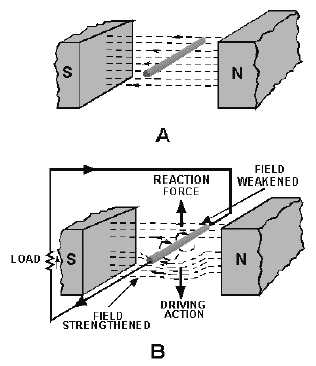1-11
Figure 1-10.—Motor reaction in a generator.
The interaction between the conductor field and the main field of the generator weakens the field
above the conductor and strengthens the field below the conductor. The main field consists of lines that
now act like stretched rubber bands. Thus, an upward reaction force is produced that acts in opposition to
the downward driving force applied to the armature conductor. If the current in the conductor increases,
the reaction force increases. Therefore, more force must be applied to the conductor to keep it moving.
With no armature current, there is no magnetic (motor) reaction. Therefore, the force required to turn
the armature is low. As the armature current increases, the reaction of each armature conductor against
rotation increases. The actual force in a generator is multiplied by the number of conductors in the
armature. The driving force required to maintain the generator armature speed must be increased to
overcome the motor reaction. The force applied to turn the armature must overcome the motor reaction
force in all dc generators. The device that provides the turning force applied to the armature is called the
PRIME MOVER. The prime mover may be an electric motor, a gasoline engine, a steam turbine, or any
other mechanical device that provides turning force.
Q13. What is the effect of motor reaction in a dc generator?
ARMATURE LOSSES
In dc generators, as in most electrical devices, certain forces act to decrease the efficiency. These
forces, as they affect the armature, are considered as losses and may be defined as follows:
1. I2R, or copper loss in the winding
2. Eddy current loss in the core
3. Hysteresis loss (a sort of magnetic friction)

